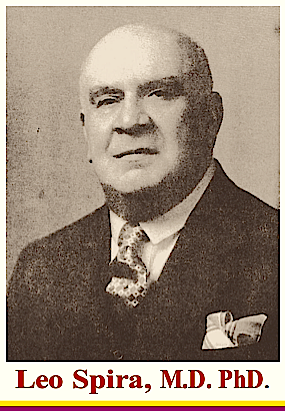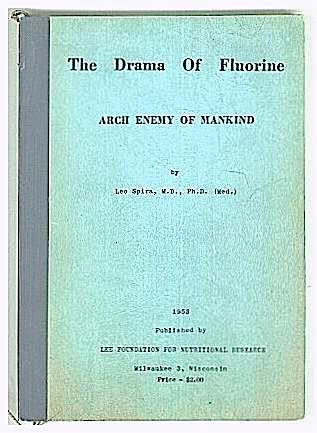FLUORIDE AND THE ZINC LINK — Leo Spira +
The papers, books, and links below testify to the importance of zinc
for plants, animals and humans. Illnesses, episodic violence,
hyperactivity, learning disabilities, depression, crime,
behavioural problems, reduced sexual reproduction
and alcohol intolerance, anorexia nervosa,
are associated with zinc deficiencies
in humans, and as it is a given that
fluorides are antagonists of zinc,
the hazards of fluorides in
food, air and water need
to be reduced urgently.
→ Fluorides, Zinc and Anorexia Nevosa ←
↑ RECOMMENDED ↑
Physical chemical effects of zinc on in vitro enamel…
Item 6 is of interest to andrologists!
LEO SPIRA (#9) on the right, 3rd from the front. (See also the end of this post)
26 January 1947 – The Belmont Hotel in Chicago.
PFPC NEWSLETTER #5 – “Spira, Fluoride and the Zinc Link”
Editors note:
We recommend this short read especially item 5 and 6.
Note Item on * Down Syndrome
2000 PFPC (Feel free to distribute)
20 May 2000
IN THIS ISSUE:
1) INTRODUCTION
2) LEO SPIRA
3) WHAT IS ZINC DEFICIENCY?
4) ADVERSE HEATH EFFECTS OF ZINC DEFICIENCY
5) BRAIN, ZINC, BEHAVIOUR AND CHILDREN
6) THE ROLE OF FLUORIDE IN ZINC DEFICIENCY
. . . -. . . .
1) INTRODUCTION
Hi Everyone,
In the past we have written about fluoride/aluminum complexes and the ability of aluminum to greatly potentiate the toxicity of fluoride, especially as it relates to G protein activation and thyroid pathology. Fluorides directly imitate the biochemical activity of thyrotropin, the thyroid-stimulating-hormone (TSH).
In this newsletter we will turn our attention to zinc and its importance in thyroid function, and the role of fluoride in inducing zinc deficiency.
It is TSH that mediates iodine, zinc and selenium (Bellisola et al, 1998; Arreola et al, 1993).
Abnormal zinc metabolism occurs commonly in thyroid disease. Zinc levels in red blood cells have become an important marker of peripheral tissue response to thyroid hormones, indicating duration of pre-existing thyroid disease (Tiran 1993). In the clinical laboratory, the main interest of zinc determination in red blood cells now concerns thyroid pathology (Vitoux et al, 1999). A hyperthyroid person will reveal highly elevated serum zinc levels, but a reduced zinc content in whole blood, while the reverse changes are observed in the hypothyroid patient. There a reduced serum zinc content is seen, with highly increased zinc content in whole blood.
Zinc is thought to be of importance to thyroid hormone synthesis in the liver. Zinc may play a role in thyroid hormone metabolism in “low T3” patients and may in part contribute to conversion of T4 to T3 in humans. In some cases supplementation with zinc normalized the T3/rT3 ratio (Licastro et al, 1992; 1993)
However, after treatment for thyroid dysfunction, normalization of zinc in red blood cells occurs, lagging about 2 months behind normalization of plasma T4 and T3 levels (Yoshida 1996; Varga, 1994). This is a clear sign that many cases of “zinc deficiency” are NOT caused by an actual nutritional lack of zinc, but by thyroid dysfunction. The symptoms of “zinc deficiency” are identical to the ones ascribed to hypothyroidism.
Many nutritional deficiencies are not due to an actual lack of said nutrients in the diet, but due to hypothyroidism. Thyroid hormones modulate nutrient and vitamin transport. When hypothyroid, the entire blood chemistry changes. Just as is the case with calcium (May 1950), magnesium (Shibutani et al, 1989), sex hormone-binding globulin (Foldes et al, 1990), somatomed in (Marek et al, 1981), etc., so zinc urine concentrations are elevated in hyperthyroidism (Nishi et al, 1980), but decreased in hypothyroid patients (Tsou et al, 1993; Buchinger et al, 1988).
We hope that this Newsletter is not too complicated. If you do have any questions, please don’t hesitate to contact us.
Best wishes to all,
Andreas Schuld
→ Parents of Fluoride Poisoned Children (PFPC) ←
Vancouver, BC, Canada
↑ Much info here on salt fluoridation ↑
2) LEO SPIRA
In 1953 Leo Spira, MD, Ph.D. published his book “The Drama of Fluorine – Arch Enemy of Mankind.” Drawing upon his many articles which had been published in the Lancet, the British Dental Journal, and other recognized medical journals, the great British physician summarized his findings of over 30 years of pioneering research into various disease states he ultimately found to be related to fluoride intake.
One of the most frequent symptoms of early fluorosis observed by Spira were “mottled” and deformed nails“, which would often split or chip.
“The commonest feature, however, was the occurrence of raised longitudinal ridges on the surface of the finger and toe-nails…In addition, dull, opaque, chalky-white specks, patches or transverse bands, such as are familiar to everybody, appeared frequently on several nails…”
Further Spira wrote, “There was a frequent complaint that the hair was falling out prematurely.”
In addition Spira reported of several skin diseases and wrote, “Patients felt apprehensive and irritable and were subject to frequent attacks of depression and even melancholia with loss of energy and general lassitude”.
The symptoms Spira was describing were later referred to in other European literature as the “Spira-Syndrome” (Schoehl, 1985). It must be clear to any endocrinologist that the conditions Spira was describing in the early part of the past century are identical to those now commonly ascribed to zinc deficiency and/or hypothyroidism.
On a courtesy visit to the US, Spira had asked the PHS if they also had observed such symptoms, and was told that this was not quite the case. However, recent documents obtained show that the opposite was true. Even Dean himself had noticed such symptoms and wrote about them already in 1932:
“The hair of some of these mottled enamel cases is unusually coarse, almost like horse hair. Finger nails are apparently not normal. Two of the three local physicians state that there is apparently an unusually large account of skin disorders among those using the city water supply. Future surveys will attempt to obtain this additional dermatological data in order to determine whether it correlates with the mottled enamel.”
[from: T. Dean’s monthly report to Surgeon General Hugh S. Cumming, March 4, 1932, part of the H. Trendley Dean collection, History of Medicine Section, National Library of Medicine).]
Discussing a study at 8ppm, we find 3 to 5 blotches per nail:
“Another change noted was in the nails. From 10-20 percent of the younger individuals examined has a rather unusual type of nail structure, the most characteristic aspect being transverse white blotches often completely across the nail, usually symmetrical and on all the nails, there very frequently being from three to five of these per nail. [ See our image of nails below. ] The incidence of these finally decreased with age, the oldest patient being 57. In the control area with 139 high school students examined, none showed transverse striations.”
[Abstracts of the proceedings of the meetings of the Technical Advisory Committee on the fluoridation of water supplies with the Departmental Working Committee for the Newburgh-Kingston Demonstration; Harold C. Hodge, chairman; April 24, 1944; part of the H. Trendley Dean collection, History of Medicine Section, National Library of Medicine).]
3) WHAT IS ZINC DEFICIENCY?
Zinc is an essential trace mineral which was first recognized as dietary essential in 1934. Prior to 1963, zinc deficiency in human was unknown. The first deficiency was noted in Iran and Egypt (Prasad et al, 1963). Today, it is recognized that a nutritional shortage of zinc is common throughout the world. AUSTRALIA – A marginal deficiency of zinc appears to be prevalent in many segments of populations in developed countries, and more severe deficiencies are widespread in many parts of the world. Iron and zinc deficiencies, often occurring simultaneously for reasons which will be described elsewhere, are considered the leading world health dietary mineral problems.
[Zinc deficiencies are very common in Australian Soils]
Zinc plays a vital role in biochemical function as it is the essential component of the active site of a multitude of enzymes. Thirty years ago, only three enzymes that required zinc for their activities were identified; today more than 300 such enzymes have been classified (Prasad, 1996).
In 1974, the Food and Nutrition Board of the National Research Council of the National Academy of Sciences decided to establish a recommended dietary allowance for zinc as an essential element for humans. It is only in the last 10 to 20 years that extensive research into zinc has taken place. Alone between 1990 and 1998 over 3600 studies on zinc were added by the National Library of Medicine.
The discovery of zinc “finger proteins” within the past two decades has further led to vastly improved understanding of how cells replicate and divide. Zinc is required for each step of cell cycle in microorganisms and is essential for DNA synthesis (Prasad, 1989). Considering that nuclear receptors for the steroid/thyroid superfamily (which are all G-protein-coupled) are also all zinc finger proteins, it is not surprising that zinc deficiency impairs the metabolism of thyroid hormones, and rogens, and growth hormones. Recent research also indicates that zinc finger proteins are required for binding of G proteins and GTP hydrolysis (Vitaleet al, 1998).
Zinc is probably involved in more body functions than any other trace mineral.
Zinc is also involved in blood pH regulation.
4) ADVERSE HEATH EFFECTS OF ZINC DEFICIENCY:
Zinc deficiency affects function of the testes, liver and muscles, and affects the structure of bones, teeth, hair and skin. Deficiency of zinc is associated with short stature, anaemia, increased pigmentation of skin (hyperpigmentation) -> Spira’s “mottled skin”, enlarged liver and spleen (hepatosplenomegaly), impaired gonadal function (hypogonadism), impaired wound healing, and immune deficiency, and cancer.
In animals, studies on reproduction have shown a significant reduction in the number of alive newborns in a group of rats submitted to severe zinc deficiency, confirming that zinc is a very important trace element overall during pregnancy (Sole et al, 1995). In rhesus monkeys, marginal zinc deficiency during gestation and during the 1st yr of life was found to be associated with significantly delayed skeletal maturation and defective mineralization (!). This abnormality of bone mineralization suggests that zinc plays an important role in endochondral bone formation (Leek et al, 1984).
In rats, growth rate, DNA level, RNA level, organ/serum zinc contents and alkaline phosphatase activities are markedly affected by zinc deficiency. Zinc deficiency significantly reduced growth rate by up to 60% in rats. (Okegbile et al, 1998; Ninh et al, 1998)
Of potentially extreme importance to humanity are the findings in test animals that zinc deficiency induced a chronic immunosuppression that persisted through the third generation of their offspring (Beach et al, 1982). (Of course similar effects lasting several generations have also been documented in fluoride-related literature.) Needless to say, if this also holds true for zinc-deprived humans, humanity certainly faces a grim future filled with disease.
* Humans:
Suboptimal zinc status can seriously impair human health, performance, reproductive functions, and mental and physical development (Roth and Kirchgessner, 1999). Zinc deficiency affects testicular functions adversely in man and animals. Zinc is essential for spermatogenesis. (Prasad, 1989)
Growth retardation, male hypogonadism, skin changes, poor appetite, mental lethargy and delayed wound healing are some of the manifestations of chronically zinc-deficient human subjects. In others, dermatological manifestations, diarrhea, hair loss, mental disturbances and intercurrent infections predominate. (Prasad, 1989). Several studies have shown that zinc deficiency is common in older people (Abbasi and Shetty, 1999)
Low levels of zinc are associated with advanced gastrointestinal cancer (Jia, 1991) – as is selenium, and lung cancer (Piccinini et al, 1996). A study testing zinc and copper levels in erythrocytes, plasma, and whole blood in 35 various cancer patients, comparing to 24 normal individuals, found a decrease in zinc in all three blood constituents of the cancer patients (Aldor et al, 1982).
Depending on the country, 5-30% of children suffer from moderate zinc deficiency, responsible for small-for-age height (Favier et al, 1992).
*Down Syndrome
As reported in PFPC NEWSLETTER #2, the number of excess Down Syndrome births due to water fluoridation is estimated to be several thousand cases annually throughout the world. All patients with with Down Syndrome have higher TSH levels (Licastro et al, 1992;1993), so it is obvious that the disease would occur more frequently in areas where a direct TSH mimick is in the public water supplies. In Down Syndrome, hypothyroidism is the most common endocrinological deficit (Bucci et al, 1999). A close correlation was found between changes in plasma levels of zinc and changes in TSH in patients with chronic renal failure (Arreola et al, 1993).
In a study on children with Down Syndrome, ALL children had lower zinc levels than controls (Toledo et al, 1997). Zinc supplementation was successful in DS and restored the T3/rT3 ratio to normal in several trials. (Licastro et al, 1992;1993), further showing evidence that zinc is essential for T4 to T3 synthesis in peripheral tissue.
5) BRAIN, ZINC, BEHAVIOUR AND CHILDREN:
Despite the widespread incidence of childhood zinc deficiency and strong evidence that zinc deprivation during periods of rapid growth affect brain development and behavior in animals, there is little research on the behavioral effects of zinc deficiency in children or adults. (Penland, 2000)
A new study on rats, published in the March 2000 issue of Brain Research, shows that a proper zinc supply to the brain is necessary for improvement and maintenance of learning ability. Synaptosomal zinc in the hippocampal formation and cerebral cortex was significantly decreased by 12 weeks of zinc deprivation. The results suggested that the decrease of vesicular zinc in the hippocampal formation and cerebral cortex is involved in the transient learning impairment of adults rats (Takeda et al, 2000).
Zinc levels in brain influence other brain metal content. One study investigated the effect of severe zinc deficiency on the distribution of nine elements in brain regions. Zinc deficiency caused an elevation in copper concentrations in most brain parts. Levels of calcium, manganese, sodium and potassium, in certain brain regions, also appeared to be altered by the zinc status of an animal. The levels of other metals were dependent on zinc nutriture. The data suggest the hypothesis that changes in brain metal content, associated with zinc deficiency, contribute to the behavioral abnormalities that occur. (Wallwork et al, 1983)
In rats fed green tea and black tea (extremely high in both F- and Al), zinc contents in the cerebrum were gradually decreased with the increase of tea leaves dose and tea concentration. While cerebrum calcium concentrations were also significantly reduced, aluminum levels increased (Zeyan et al, 1998).
In plasma, zinc and copper are in a direct oppositional relationship. Clinical observations and research have indicated that the copper/zinc ratio appears to be more decisively important than either of the individual metals alone. Zinc deficiency results in elevated blood levels of copper, due to the dynamic competition of these metals in the body. Elevated blood copper and decreased zinc levels have been associated with episodic violence, hyperactivity, learning disabilities, and depression in humans.
The high incidence of zinc deficiency in assaultive young males was illustrated in a recent study which found elevated serum copper and depressed plasma zinc concentration, compared to normal controls.
This study confirmed earlier clinical observations of zinc depletion in more than 4,000 behavior disordered patients (Walsh, 2000).
Dietary zinc deficiency also decreases plasma concentrations of vitamin E (Bunk et al, 1989).
Studies on depression showed significantly lower zinc levels in major depressed patients than in normal volunteers and it was suggested that lower serum zinc in depression may be due to interference in the liver (Maes et al, 1999).
6) THE ROLE OF FLUORIDE IN ZINC DEFICIENCY
Fluorides cause “zinc deficiency”. Both organic and inorganic fluoride compounds have shown to inhibit zinc containing enzymes, such as carbonic anhydrase (Dugad et al 1988,1989; Gelb et al, 1985) which is also now used as a marker for thyroid dysfunction (Hori et al, 1998). [Note: Carbonic anhydrase inhibitors reduce cerebrospinal fluid (CSF) production!]
Zinc depletion follows experimental fluorosis in mice (Kanwar and Singh,1981). In the liver a significant fall in the levels of zinc was registered. Effects were directly dose-dependent, just as is the case with fluoride-induced iodine deficiency. The liver is the major organ for thyroid hormone synthesis. Only 20% of T3, the biologically active thyroid hormone is manufactured in the thyroid itself. The rest occurs in peripheral tissue, mainly the liver.
In rats fed pure spring water (natural FØ concentration = 0.2 ppm) or spring water enriched with NaF to result in 0.8, 1.1 or 2.2 ppm FØ during180 days, zinc ions were depleted in most tissues (Boeckhhaebisch & Oliveira, 1997).
→ → → Other work has also shown that a fluoride intake in rodents comparable to the total intake by man in fluoridated areas, leads to zinc deficiency in the testis, liver and kidneys (Krasowska, 1992, 1996).
Zinc protection from fluoride-induced testicular injury
Alicja Krasowska Institute of Biology,
University of Białystok, Poland ↓
http://www.researchgate.net/publication/8601023_Zinc_protection_from_fluoride-induced_testicular_injury_in_the_bank_vole_(Clethrionomys_glareolus)
Li et al (1994) showed that excessive fluoride intake since early childhood reduced mental work capacity and that the effect on zinc metabolism was a mechanism of influence by excessive fluoride intake, echoing earlier reports by Shen et al (1992).
Hlynczak et al (1980) also found significant alterations in workers exposed to fluorine compounds.
*Mottled teeth anyone?
Zinc deficiency causes mottled teeth in rats (Teraki and Ishiyama, 1990).
Zinc and fluoride were water quality variables associated with mottling in a study investigating the prevalence of dental mottling in school-aged lifetime residents of 16 Texas communities (Butler et al, 1985). Platelets from zinc-deficient rats take up significantly less external calcium. Low zinc status in rats impairs calcium uptake and aggregation of platelets stimulated by fluoride. (Emery & O’Dell, 1991; 1993)
MORE INFO:








